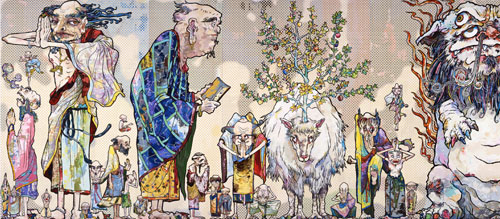An enormous 100 meters in length, The 500 Arhats qualifies as one of the largest paintings in history. This second edition of our blog showcasing works in the exhibition takes a close-up look at “Black Tortoise” and “Vermilion Bird,” two of the four sections comprising The 500 Arhats.
The 500 Arhats - “Black Tortoise” and “Vermilion Bird”
The creature that reigns over the north is usually portrayed as a cross between a turtle and a snake, but in Murakami's work the creature itself is not depicted. Instead, the sacred mountain in the center and the sacred animal, Shen, next to it serve as substitutes for images of a turtle and snake, respectively. When it was exhibited in Doha, Qatar in 2012, this section of the painting was incomplete, lacking among other things the fourth giant sacred animal, making it the first exhibition of the completed work anywhere in the world.

Takashi Murakami
The 500 Arhats [Black Tortoise] (detail)
Installation view: “Takashi Murakami: The 500 Arhats,” Mori Art Museum, 2015
Photo: Takayama Kozo
© 2012 Takashi Murakami/Kaikai Kiki Co., Ltd. All Rights Reserved.
The Vermilion Bird that reigns over the north incorporates images from Tezuka Osamu's Hinotori (Phoenix) based on early-modern Chinese phoenix designs. Arhats, who float freely in the space-like background, almost appear as if they have visited us riding on gigantic waves for the purposes of spirit pacification.
In this work, for which Murakami and his assistants examined various arhat imagery from the past as part of an effort to create a decidedly modern depiction of the Five Hundred Arhats, traditional Eastern iconography and elements borrowed from contemporary magazines and manga form a harmonious unit.
Some have called it “Murakami's Guernica,” referencing Pablo Picasso's masterpiece Guernica, which was painted as a response to the tragedy of the Spanish Civil War. Confronted with the Great East Japan Earthquake and Tsunami and the subsequent nuclear power plant disaster, many artists were seized by a sense of helplessness, while others undertook various activities in response.
When a society finds itself in a critical situation, what is it that its artists and art can do? In order to convey a message from the past to the present, and from the present to the future, Murakami has joined forces with young artists to produce the kind of massive painting that will stand the test of time.
Indeed, one could say that The 500 Arhats is Takashi Murakami's answer to this question.

Installation view: “Takashi Murakami: The 500 Arhats,” Mori Art Museum, 2015
Photo: Takayama Kozo
© Takashi Murakami/Kaikai Kiki Co., Ltd. All Rights Reserved.
■Relevant Information
・“Takashi Murakami: The 500 Arhats”
Saturday, October 31, 2015 - Sunday, March 6, 2016
・“Takashi Murakami: The 500 Arhats” Works of Murakami
(1)The 500 Arhats--“Blue Dragon” and “White Tiger”
(2)The 500 Arhats--“Black Tortoise” and “Vermilion Bird”
(3)Making The 500 Arhats
(4)New painting series
(5)The Birth Cry of a Universe
(6)Mr. DOB, Tan Tan Bo, Gero Tan
(7)Bonus! Murakami Arhat Robot








